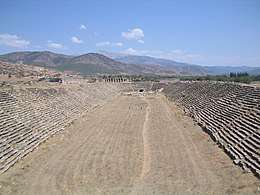Hippodrome
The hippodrome (Greek: ἱππόδρομος) was an ancient Greek stadium for horse racing and chariot racing. The name is derived from the Greek words hippos (ἵππος; "horse") and dromos (δρόμος; "course"). The term is used in the modern French language and some others, with the meaning of "horse racecourse". Hence, some present-day horse racing tracks also include the word hippodrome[1] in their names, such as the Hippodrome de Vincennes and the Central Moscow Hippodrome.

Overview
The Greek hippodrome was similar to the Roman circus. The hippodrome was not a Roman amphitheatre, which was used for spectator sports, games and displays, or a Greek or Roman semi-circular theatre used for theatrical performances.
The Greek hippodrome was usually set out on the slope of a hill, and the ground taken from one side served to form the embankment on the other side. One end of the hippodrome was semicircular, and the other end square with an extensive portico, in front of which, at a lower level, were the stalls for the horses and chariots. At both ends of the hippodrome there were posts (termai) that the chariots turned around. This was the most dangerous part of the track, and the Greeks put an altar to Taraxippus (disturber of horses) there to show the spot where many chariots wrecked.
A large ancient hippodrome was the Hippodrome of Constantinople, built between AD 203 and 330. However, since it was built to a Roman design, it was actually a circus.
List of Roman hippodromes
List of modern horse racing venues
See also
19th Century:
- Beirut Hippodrome
- Kensington Hippodrome
- Madison Square Garden (1879) known as the "Great Roman Hippodrome"
Modern:
- Sport venue
- New York Hippodrome Theatre
- Birmingham Hippodrome Theatre
- Bristol Hippodrome Theatre
- Hippodrome Theatre (Baltimore), aka The France-Merrick Performing Arts Center
- Hippodrome Theater (Richmond, Virginia)
References
- Chisholm, Hugh, ed. (1911). . Encyclopædia Britannica (11th ed.). Cambridge University Press.
- ]http://corinth.sas.upenn.edu/lykaion/ly-plan.html Archived 2006-12-07 at the Wayback Machine
- https://www.sciencedaily.com/releases/2008/07/080714145253.htm
External links
![]()
